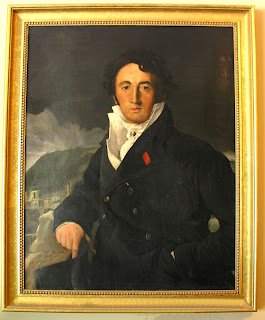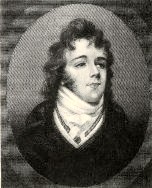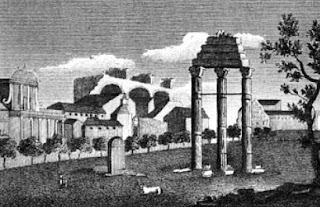 |
| John Klawitter's painting |
I recently received an email from John Klawitter asking me about this painting which he and his wife had inherited. It is a portrait of an unknown gentleman by an unknown painter and he wondered if I could shed any light on it.
What does the painting show us?
The gentleman is wearing a dark, probably blue, double-breasted coat with a red ribbon on his left lapel. His shirt collar is high and he wears a white neck cloth adorned by some kind of silver brooch. His hair is dark and wavy and he has sideburns, which look quite similar to Beau Brummell’s.
 |
| George Brummell from The History of White's by Hon Algernon Bourke (1892) |
 |
| "Campo Vaccino" - the Roman Forum from A New Picture of Rome by Marien Vasi (1824) |
The clothes and hairstyle would indicate that the portrait was probably painted in the early 19th century. The ruins in the background immediately suggested to me that it might have been painted to celebrate the gentleman’s Grand Tour – probably painted in Rome, as often happened.
My research
Armed with these clues I searched on the internet for early 19th century portrait artists who had painted in Rome. I came up with the name of the French painter Jacques-Louis David, but I was by no means convinced. Then I looked at the work of his pupil, Jean-Auguste-Dominique Ingres, and to my amazement and delight, there was the gentleman in the painting amongst his work!
The gentleman finds a name
The subject of the portrait is Charles-Joseph-Laurent Cordier and on some websites the painting title gives an indication of who he was: "Charles Cordier (1777-1870), Inspecteur des domaines à Rome et Paris."
He was painted in oils by Ingres in 1811 who was based at the Villa Medici in Rome at this time. The painting is owned by the Louvre, Paris.
But who painted this portrait?
One mystery solved. But the other question remains: who painted John’s portrait?
John’s painting differs from the one in the Louvres by a few details such as the fob. Could Ingres have made the copy himself or was it painted by another artist? Was it a contemporary copy or was it painted many years after? Any ideas?
Sources used include:
Bourke, Hon. Algernon, The History of White's (1892)
Vasi, Marien, A New Picture of Rome and its environs, in the form of an itinerary (1824)
Wikipedia

Rachel
ReplyDeleteSplendid detective work! You have, in he space of a week uncovered more about the painting than any of us in the over 40 years since my mother-in-law bought the painting. As it is unsigned, we can't really call it a fake. However, it is certainly a copy of the Ingres original, and perhaps even a copy of a copy. Wonderful, and I can't thank you enough for putting us on the right track. Should I find out more about the life and times of the subject, Charles-Joseph-Laurent Cordier, I will pass it on.
John Klawitter
Thank you - I am very glad that I could help :)
DeleteRachel, I'm learning so much about the art reproduction world! It seems there are dozens of services willing to paint a copy of the Ingres original. And this must have been a common practice, as the painting my mother-in-law bought in NY over 40 years ago must be one of dozens (or hundreds) of copies painted over the generations. Although the face is sensitively done, articles from the original are missing, primarily the ornate watch or watch fob at the subject's waist.
ReplyDeleteAbout the subject of the painting: There is some disagreement whether this is Charles-Joseph-Laurent Cordier, "an official of the Imperial Administration in Rome", or Pierre-Louis-Antoine Cordier, 'a French geologist and botanist.' However, as Ingres was in Rome when the original was painted, and other sketches of Pierre do not resemble the Ingres oil, the weight of opinion is heavily in favor that it is indeed Charles-Joseph-Laurent Cordier, an official of the Imperial Administration in Rome...I think (but do not know) this would be the French administration in Rome.
Again, Rachel, thank you for your marvelous historical detective work. I can see why your novels are known for their historical realism as well as the romance, human involvement and passion.
John Klawtter
Nice piece of detective work!
ReplyDeleteThank you - I always did like a good mystery to solve :)
DeleteWell-detected!
ReplyDeleteThanks - it was very satisfying when I found a match!
DeleteAnother point please. You will notice that the romantic ruins background looks as if someone just put it in the canvas and then this painting was made. It is a well known fact that portrait painters in Regency times spent their time between commissions painting backgrounds- like this one or others encountered during the Grand tours before the Napoleonic wars- and when a portrait was comissioned, it was Voila, choose the background, and we'll paint you in!
ReplyDeleteYes, of course - that is probably the case in this picture. What is stranger is when they paint the whole person and then just paint the sitter's face in. This results in virtually identical paintings!
Delete